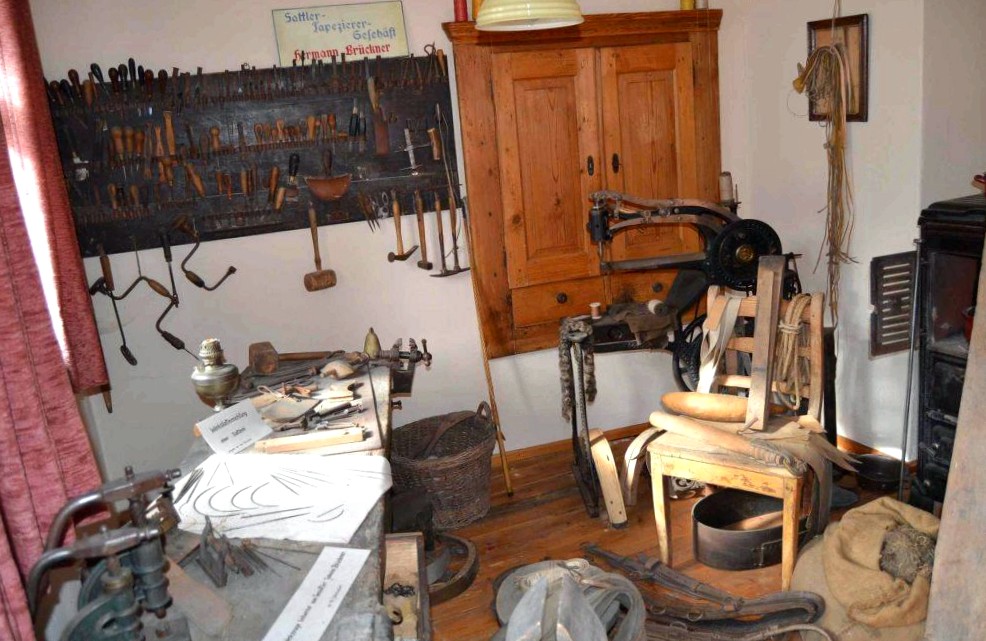
A kummet is at best still known as a decoration on the garden house. The collar is a harness around the neck of the horse to be able to pull the wagon or work equipment. For saddlers, it was often the main occupation to make these – not saddle, as the job title suggests. "No one rode them. The horses were used as workhorses", tells reinhold geldner, chairman of the french-swiss association (FSV) hiltpoltstein. The comb is one of the treasures from the years after 1871, which can be found in the gatehouse in hiltpoltstein. The room in which the club members housed this treasure was the living room of. The saddler worked and tinkered in the annex of the gate. Downstairs was the stable, upstairs the workshop. However, it was only one of the saddleries in the village.
Very well equipped
"He had all the tools, he was a very well equipped saddler", female geldner. We are talking about johann friedrich bruckner and then his son johann wilhelm bruckner, who were known as "torsattler" were known and whose descendants have left the treasure from the past time as a loan to the association. For the club members it is not easy to accommodate this in the small living room, there is still so much available. There is a leather machine, a strong sewing machine, with which leather could be sewn. Also shoes, with which kummets were decorated, are still present. "Even a seaweed plucking machine is still there", explains geldner. It loosened the seaweed, which was used to upholster the upholstered furniture, and also horsehair. This and springs were still in the saddlery. For reasons of space, the wooden board on which the leather was cut is still stored in the attic.
When the machines came
The machines and materials are an important indication of the saddler’s work. The torsattler was obviously an open-minded, modern saddler, because he probably also made upholstered furniture in later years. Every training was important. "When the machines came, leather belts were needed to drive these machines", female geldner "if the leather strap broke, it had to be done quickly when the farmers were threshing." Making or reconnecting these leather straps was also a task for the saddler. Upholstering the front plate for the shoes when they pulled the devices over the field was also part of the saddler’s job. All of this can be seen in the tools that are available. Only one thing does not exist: an order book. How much work the saddler had, from which area the orders came and what a job cost, is therefore not known. "The saddler could not make a living from his craft alone", tells geldner. Saddlers partly farmed themselves agricultural plains. But they did not make leather shoes, even though leather was the saddler’s number one utensil. "A saddler did not work as a cobbler. The craftsmen took care of it", female geldner and refers to the saying "cobbler, stick to your guns" as a reference to this strict adherence to craftsmanship.
From the 16. Century
The existing records from the 16. In the twenty-first century, the standard trades call. "The saddler is not ahead of the game", says geldner. Saddler was more of a sideline job. Unlike other trades, there is also no saddlers’ guild. But it is known what the last "torsattler" was has made. " He had a saddler and upholsterer business, as you can read on his board", reports geldner. "From him there are still drawings uber die schulung zur herstellung von sesseln von 1951", tells the FSV chairman.
The "sattlers-karl"
Another treasure from the wedding time of the other saddler from the robner family in the village is also present. The descendant karl robner is still known by the occupational name of his ancestors: "sattlers-karl" he is called. His ancestors – four generations worked as saddlers – were located rather down in the village with the workshop, opposite the zehentstadel. The company founder johann christoph robner, born in 1752, was a master saddler and mesner and is also listed in the trade tax list of 1807. Karl robner also gave FSV a treasure from long ago. "A workbench and some tools of the saddler’s trade", reports geldner. He regrets that these are currently stored in the sporl barn for space reasons. The saddler robner’s barn used to house the stagecoach horses for a time. At least these horses needed a saddle and were in good hands with the saddler.